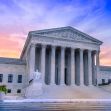The federal court system is inching one step closer to the digital age as the federal judiciary has just announced the start of a pilot program that will live-stream cases of high public interest.
The pilot program will run for the next two years. During this time, listeners can tune in to a live audio stream that will allow them to listen to the hearing proceed in real-time. The program was first announced in March during a meeting of the Judicial Conference Committee on Court Administration And Case Management. Currently, 13 district courts are participating in the pilot program. They include:
- Northern California
- Southern Florida
- Northern Georgia
- Kansas
- Montana
- Eastern Missouri
- Nevada
- Northern New York
- Western Pennsylvania
- Rhode Island
- Eastern Tennessee
- Eastern Washington
- Washington D.C.
The live audio streams will take place on official court system YouTube channels. The pilot program will have some rules, including that all the parties involved in the case will need to give their consent to the live stream, and the presiding judge will be given a say on whether or not the case will be streamed.
Additionally, cases that have sealed, confidential, and classified materials will not be streamed, and trials and civil proceedings that have jury and witness participation are off-limits as well. The courts will still maintain a level of control over the streams in that it will be illegal for the live streams to be recorded or rebroadcast.
Some states have already begun dabbling in live audio streaming. On December 7, the Northern District of Georgia live-streamed the audio of a hearing on a lawsuit related to the 2020 presidential election. That live stream drew in a whopping 42,000 listeners.
In the Eastern District of Missouri, a status conference for the case of U.S. v City of Ferguson was also live-streamed in September.
Judge Fleissig, the chair of the Judicial Conference’s Committee on Court Administration and Case Management, said of the live streaming, “The pilot reflects the judiciary’s commitment to transparency and to increasing public access to court proceedings — an issue that has taken on even greater importance in the last year.”
Judge Fleissig cited the pandemic as a trigger for moving into a virtual forum to continue operations in the judicial system. Fleissig noted, “At the same time, we want to develop the best practices for the process and ensure that any new practices do not compromise the integrity of federal court proceedings. That is why we are taking a measured and deliberative approach by working with volunteer pilot courts to test audio live streaming and help us improve the process.”
According to the December update of the pilot program, the mission of the pilot will be to assess how feasible live streaming the audio of cases will be. The courts express, “The experience of the pilot courts will help identify live streaming-related policy, technical, operational, budgetary, and administrative issues that the Conference may need to resolve.”
While it's not clear that this pilot program is a direct result of the COVID-19 pandemic, the timing of the program does indicate it may have been the tipping point. There is also the reality that now more than ever, the public has demanded a level of transparency in judicial hearings. With a majority of courts denying the presence of media, cameras, and recordings, these live audio streams will be one way Americans can have access to legal proceedings that may impact their lives.
Members of Congress have been known to push for transparency in court hearings for the benefit of the public as well, but many proposed laws have fallen flat. Recently, Illinois U.S. Representative Mike Quigley has pushed for live streaming both audio and video of U.S. Supreme Court cases. Quigley explained in a press release, “It is 2020, and we are long past ‘television’ – live streaming has become commonplace not just in daily life but also in most appellate courts in the country. It is long past time for the Supreme Court to join them.”






